2023年11月の記事
全9件 (9件中 1-9件目)
1
-
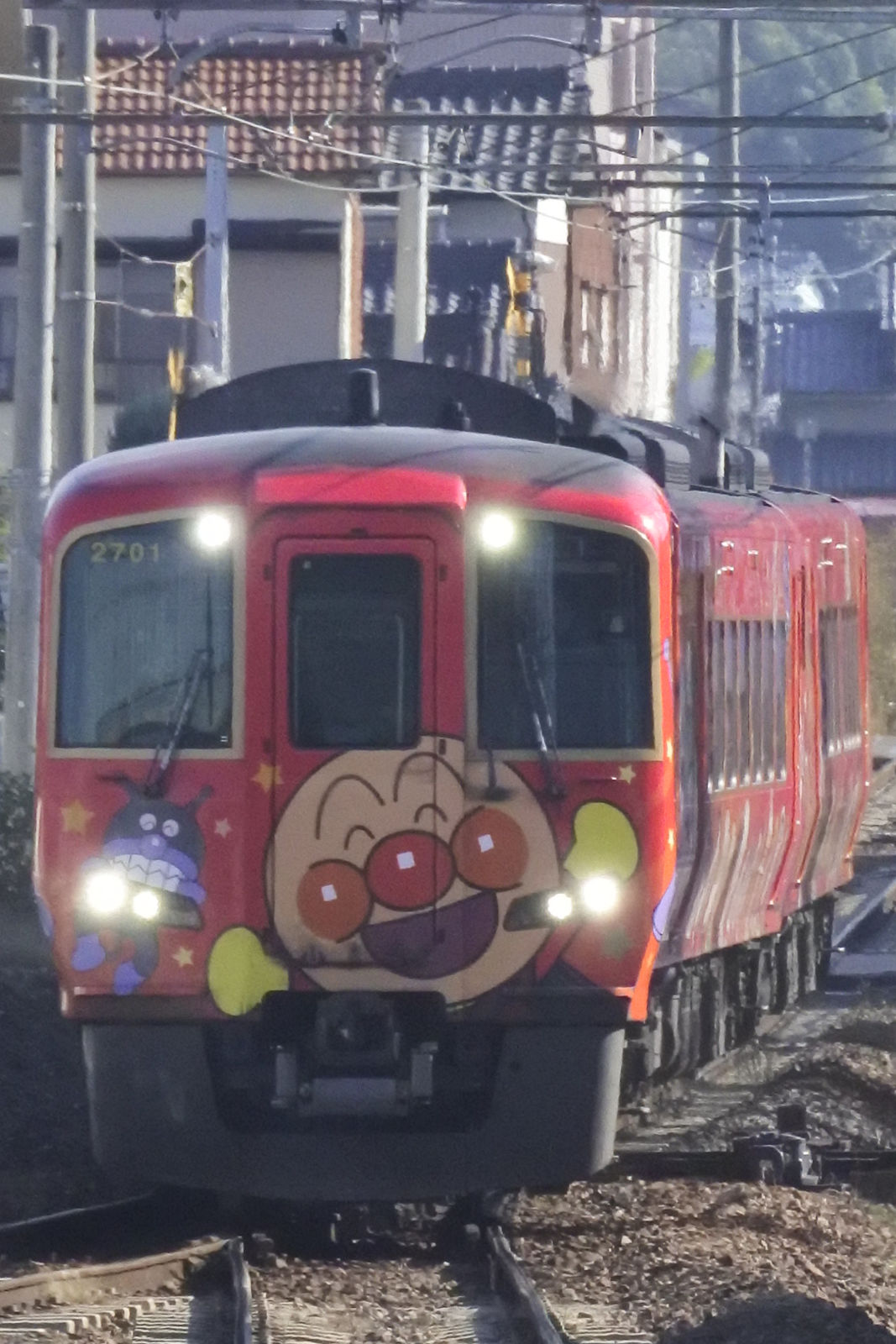
しまなみ海道と愛媛・香川を巡る旅 JR四国2700系初乗車
いよいよ四国を離れる時がやって来てしまった。JR四国土讃線琴平駅から乗る列車は、2700系気動車による「南風」岡山行き。2700系には今回が初乗車である。2700系は2019(令和元)年に登場した。2017(平成29)年より岡山駅・高松駅~徳島駅間の特急列車「うずしお」として運行していた2600系気動車を、「南風」「しまんと」にも投入しようと土讃線で試験走行を実施した結果、カーブが連続する区間がある土讃線においては、同車の空気バネ式車体傾斜装置は空気タンクの容量が足りず対応できないと判明したことから、1989(平成元)年から「南風」などで運行してきた2000系気動車で実績のある制御付き自然振り子式台車に設計変更して製造された。車体は2600系とほぼ同型である。岡山駅~高知駅間の「南風」のほか、高松駅~高知駅間の「しまんと」、岡山駅・高松駅~徳島駅間の「うずしお」、高知駅~中村駅・宿毛駅間の「あしずり」として運行されている。僕が乗った列車は「南風14号」。車両は岡山方から2701号車・2751号車・2803号車の「土讃線あかいアンパンマン列車」3両での運行だった。車体ラッピングだけでなく、車内にも天井にアンパンマンなどのキャラクターたちが描かれている、子供たちが喜びそうなかわいらしいデザインの車両。琴平駅を発車した列車は、善通寺駅、多度津駅、丸亀駅、宇多津駅、児島駅、岡山駅に停車。土讃線を走ってきた列車は多度津駅から予讃線、宇多津駅から本四備讃線(瀬戸大橋線)に入る。列車は今回の乗車区間での最大の見どころである瀬戸大橋へ。なお瀬戸大橋線宇多津駅~岡山駅間では振り子は作動しない。宇多津駅を発車して予讃線と別れ、瀬戸大橋線の高架線を上がっていくと、進行方向左側の車窓に瀬戸大橋が見えるようになった。案内アナウンスが流れるとまもなく列車は瀬戸大橋へ。瀬戸内海と瀬戸内の島々(塩飽諸島)を望みながら列車は橋を渡る。全長9367mの瀬戸大橋を渡り終えると列車は間髪入れずに鷲羽山トンネルへ入る。このトンネルがここから本州であることを知らせる目印になっている。岡山県に入って最初の停車駅である児島駅では、2番のりばに到着。向かいの1番のりばには、この日臨時列車として運行されていたキハ185系気動車キロ185-26号車とキハ32系気動車キクハ32-502号車の2両による「瀬戸大橋アンパンマントロッコ4号」が停車中だった。アンパンマンが車体に描かれた車両が並ぶとあって、ホームには親子連れの姿が多数見られた。列車は児島駅で「瀬戸大橋アンパンマントロッコ4号」を追い抜く。ここからJR西日本管轄の本四備讃線・宇野線(瀬戸大橋線)を、岡山駅までノンストップで走る。岡山駅到着前、この車両ならではのサービスが。「アンパンマンのマーチ」の車内チャイムに続いて、アンパンマン(戸田恵子さん)の声によるアナウンスが流れる。アンパンマンのアナウンスの後には通常の岡山駅到着・乗換案内アナウンスが流れ、列車は岡山駅の6番のりばへ到着した。The last train on this travel was JR Shikoku 2700 Series "Nampu".2700 Series started its regular service in 2019. At first, JR Shikoku planned to introduce 2600 Series with pneumatic tilting bogies. Due to the trial running, 2600 Series was unsuitable on Dosan Line because of the capacity shortage of air tanks for pneumatic tilting on successive curves. Instead of pneumatic tilting bogies, 2700 Series introduces pendulum-type passive tilting bogies, a proven method on 2000 Series, which has served as limited express trains since 1989.Not only as "Nampu", 2700 Series also serves as limited express trains on unelectrified lines, "Shimanto", "Uzushio", and "Ashizuri".The carriages have liveries themed around Anpanman characters (2701, 2751, and 2803). Not only their bodies but their inside ceilings were decorated.This time, I travelled from Kotohira Station to Okayama Station. During my travel, the train stopped at Zentsu-ji, Tadotsu, Marugame, Utazu, and Kojima Stations before arriving at Okayama terminal.After leaving Utazu Station, I could see Seto Ohashi Bridge over Seto Inland Sea on my left. Before the train started to cross the bridge, a guide announcement about the bridge was made. While the train was on the bridge, I saw the Shiwaku Islands over the window. Soon after the 9367-metre/5.82-mile-long bridge, the train hurtled into Mt. Washu Tunnel.At Kojima Station, "Anpanman Trocco Trolley", which also had a livery of Anpanman characters and one carriage was windowless open-air, was waiting for the train going ahead on the neighbouring track. Because the two trains with Anpanman decorations stopped at the same platform, many small children and their parents were watching the two on the platform.Soon before arriving at Okayama terminal, the melody of the theme song of Anpanman anime and an announcement by Anpanman (voiced by Keiko Toda) were made, as well as the regular announcement for transfer.
Nov 26, 2023
コメント(2)
-
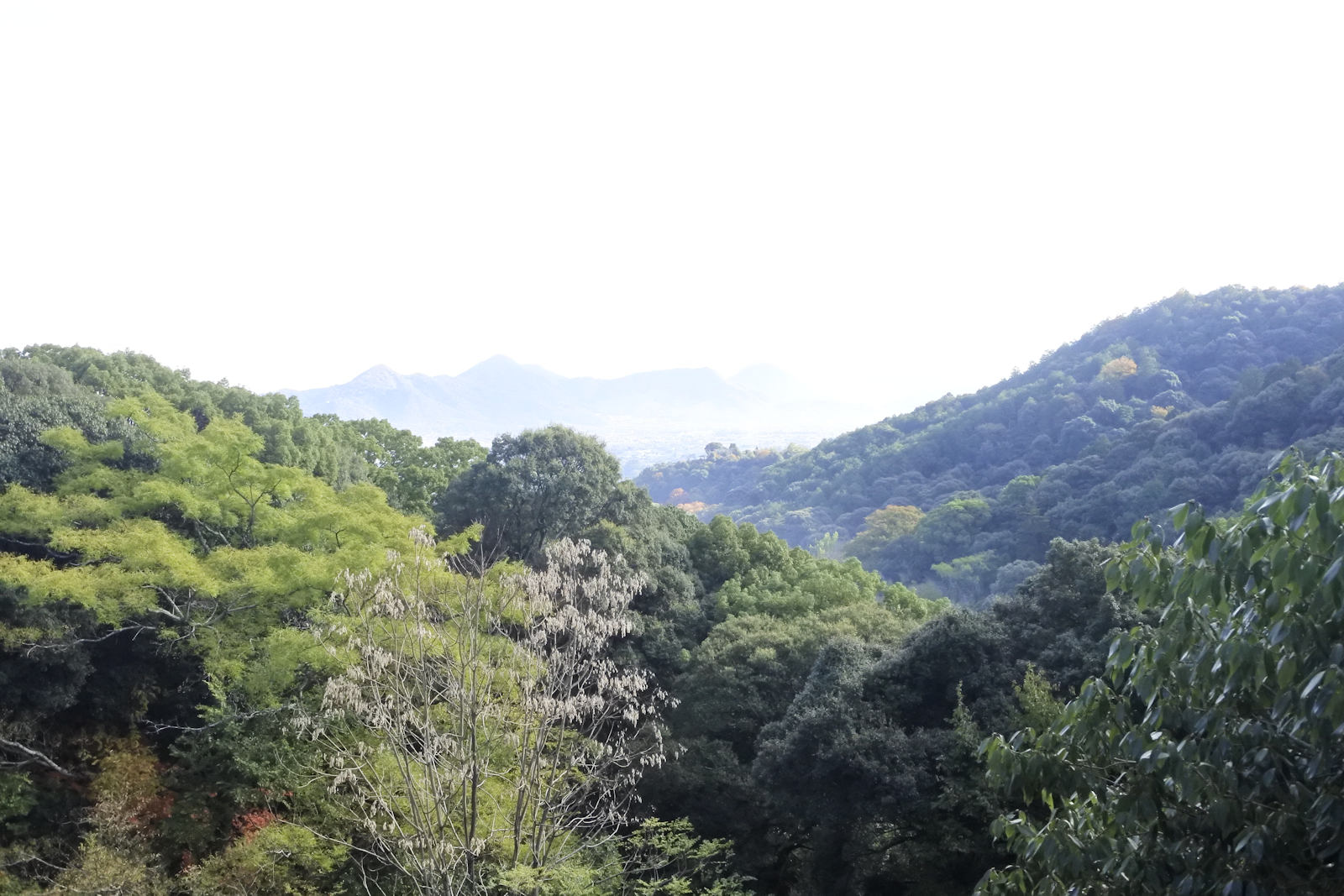
しまなみ海道と愛媛・香川を巡る旅 初めてのこんぴらさん参り
最終日の26日は、こんぴらさんこと金刀比羅宮を参拝。ことひら温泉琴参閣から神明町商店街を南東方向へ進んで表参道へ。3分ほど歩くと御本宮への長い長い階段が始まる。その数、785段。365段目にある大門の手前まではお土産屋さんが建ち並ぶ。大門をくぐるといよいよ金刀比羅宮の神域へ。そこからさらに上がって500段目からは、こねこ山や猫山、鷹丸山を望む。御本宮がある785段目までは、階段の始点から僕の足で約40分かかった。御本宮にお参りし、展望台から眼下に琴平の街並みが広がり、「讃岐富士」こと飯野山と遠くに瀬戸内海を望む。さらに進んで奥社へ。奥社まではさらに583段の階段を上り、合わせて1368段を数える。御本宮から奥社までは、同じく僕の足で約30分だった。下山後、僕はランチに表参道にあるうどん屋さん「こんぴらうどん」で讃岐うどんを食べた。今回僕が食べたのはえび天ぶっかけうどん。僕は最初、御本宮までの往復だけで疲れるかと思っていたが、奥社までの1368段を行って帰ってくることができた。初めてのこんぴら参りは、きつかったが楽しかった。On the final day of travel, I visited Kotohira-gū Shrine, commonly nicknamed Konpira-san.From Kotosankaku Hotel, I walked along Shimmeicho Street and came to the approach. Walking about 3 minutes, the stairway to the shrine. The stairway has 785 steps to the main shrine and 1368 steps to the inner shrine from the bottom. The Ōmon gate at the 365th step was the entrance of the shrine property. From the 500th step, I could seea view of mountains, such as Mt. Koneko, Mt. Neko, and Mt. Takamaru.Taking about a 40-minute walk, I came to the main shrine. From there, it also has a nice view of Kotohira Town and Mt. Iino, also called "Sanuki Fuji" because it looks like Mt. Fuji.After worship at the main shrine, I tried to walk to the inner shrine. The stairway to the inner shrine has 583 steps from the main shrine. It takes about 30 minutes on my foot.Coming back to the bottom, I ate a bowl of udon noodles at a restaurant on the approach. I chose the one topped with shrimp tempura.At first, I got tired until the main shrine. However, contrary to expectations, I could go to the inner shrine. It was hard, but it was fun to go up the stairway.
Nov 26, 2023
コメント(0)
-
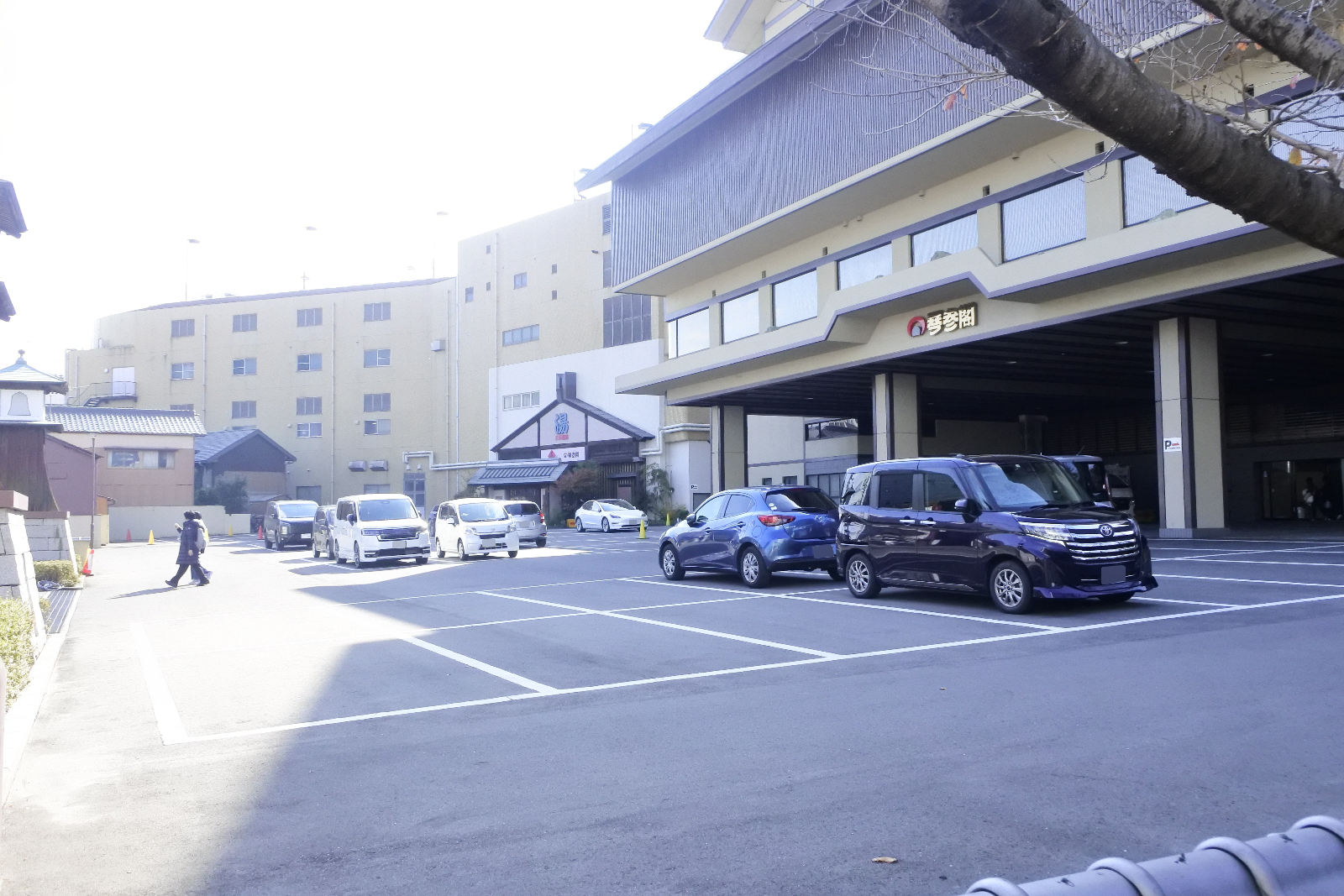
しまなみ海道と愛媛・香川を巡る旅 廃駅跡に建つ温泉宿
25日の宿は、JR四国土讃線琴平駅から歩いて6分ほど。高松琴平電気鉄道琴平線琴電琴平駅と金倉川を越えた先、1963(昭和38)年に廃線になった琴平参宮電鉄琴平線の琴参琴平駅跡地に建つ温泉旅館、「ことひら温泉琴参閣」。1988(昭和63)年開業。1階に大浴場こんぴらの湯・かぶきの湯がある11階建ての「讃水館」と1階にフロント、最上階に展望風呂八雲の湯がある10階建ての「飛天館」の2館から成る(八雲の湯は飛天館宿泊客専用)。こんぴら温泉郷の開湯(湧出)が1997(平成9)年であることから、温泉旅館となったのはそれ以降のことである。観光経済新聞社が認定する「5つ星の宿」に選出されている。今回僕が泊まった部屋は、讃水館にある金刀比羅宮が建つ山としても知られる象頭山を望む和室。讃水館1階にあるこんぴらの湯・かぶきの湯は、内風呂がジェットバスや漢方風呂など4種類、露天風呂が2種類の計6種類の浴槽があり、夜と朝で男女が入れ替わることから、1泊で最大12種類のお湯を楽しめる。夕食はエビ、ハモ、さつまいも、ししとうの天ぷらや鯛めしなど。かつて琴平参宮電鉄琴平線が走っていた頃に思いを馳せながら、いろいろな風呂に浸かり、美味しいご飯を食べて楽しい時間を過ごせた。On the night of the third day, I stayed at Kotohira Onsen Kotosankaku six minutes on foot from Kotohira station on JR Shikoku Dosan Line.The hotel stands on the site of Kotosan-kotohira Station on Kotohira Sangu Electric Railway, which closed in 1963. It has two buildings, the 11-storied "Sansuikan" and the 10-storied "Hitenkan". Sansuikan accommodates hot spring bathrooms on the ground floor, and Hitenkan does on the 9th floor (only for stayers who booked rooms in Hitenkan). The bathroom in Sansuikan accommodates four inside baths and two open-air baths.I stayed in a tatami-matted guestroom facing Mt. Zozu, whose middle Kotohira-gu Shrine stands.I ate tempura (shrimp, dagger-tooth pike conger, sweet potato, green pepper), cooked rice with red sea bream, and more at dinner.While in the hotel, I imagined how was atmosphere of Kotosan-kotohira Station and Kotohira Sangu Electric Railway Line.ことひら温泉 琴参閣
Nov 25, 2023
コメント(0)
-

しまなみ海道と愛媛・香川を巡る旅 SLが見守る街 多度津
四国鉄道文化館を後にして、JR四国予讃線と土讃線の乗換駅である多度津駅へとやって来た。多度津駅がある香川県多度津町は、1889年(明治22年)5月に現在の予讃線と土讃線の一部である讃岐鉄道線丸亀駅~琴平駅間が開業した時に讃岐鉄道車両修繕工場として建てられ、今なお続くJR四国多度津工場が多度津駅近くに立地し、1903(明治36)年から1910(明治43)年にかけて広島県・尾道からの船との乗換地点となるなど、交通の要衝だった。讃岐鉄道線は今日のJR四国の路線となったものとしては最初に開業(民鉄を含めた四国初の鉄道路線は1887(明治20)年開業の伊予鉄道高浜線松山市駅~三津駅間)したことから、「四国鉄道発祥の地」とされている。多度津駅の近くには、8620形蒸気機関車58685号機(466両目)が静態保存されている。1922(大正11)年という100年以上前に製造された。この58685号機はJR九州肥薩線などで「SL人吉」として運行されている58654号機(435両目)と同い年である。SLが令和の世を走る電車・気動車たちを見守るような構図で撮影。After leaving Shikoku Railway Cultural Center, I went to Tadotsu Station, the junction between Yosan Line and Dosan Line.Tadotsu Town, Kagawa Prefecture, has been important since Sanuki Railway Line (the present part of Yosan Line and Dosan Line) opened in 1889. The railway factory stands near Tadotsu Station, and people transferred between the ships from Onomichi, Hiroshima Prefecture, and the trains between 1903 and 1910. Among the present railways managed by JR Shikoku, Sanuki Railway Line is the oldest.Near the station along the railway, a Class 8620 steam locomotive 58685 (466th) is exhibited. The locomotive was manufactured in 1922, as old as 58654 (435th), serving as "SL Hitoyoshi" on JR Kyushu Hisatsu Line.I photographed the locomotive and the in-service trains.
Nov 25, 2023
コメント(0)
-
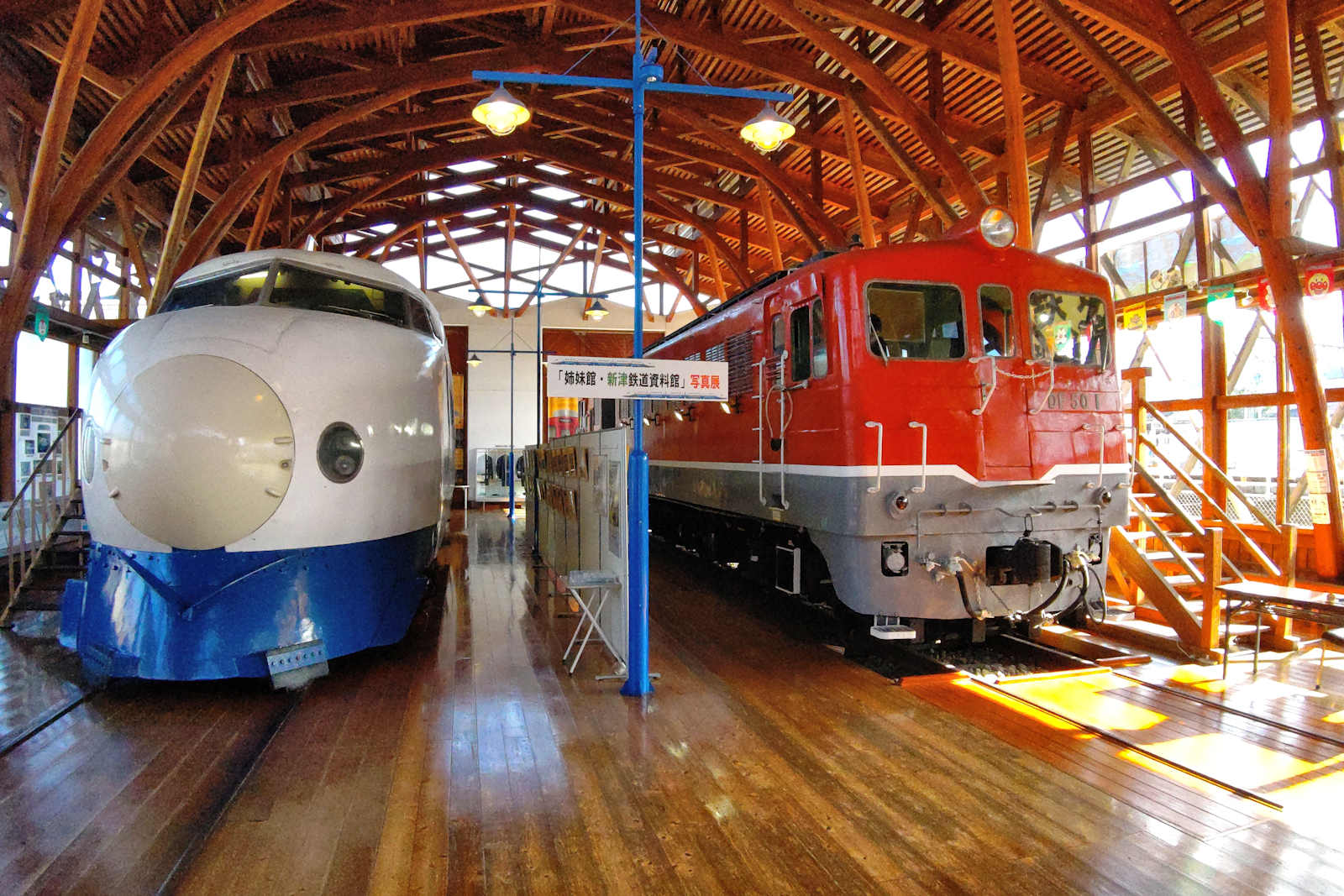
しまなみ海道と愛媛・香川を巡る旅 四国鉄道文化館を訪ねる
3日目の11月25日は、JR四国予讃線伊予西条駅近くの四国鉄道文化館へ。四国鉄道文化館は、2007(平成19)年に開館。予讃線の線路を挟んで北館と南館が建ち、両館の間は跨線橋で行き来できる。まずは伊予西条駅の駅舎側に建つ北館から。北館の前には、西条市の隣、新居浜市出身の日本国有鉄道第4代総裁で「新幹線の父」と呼ばれる十河信二さん(1884 - 1981)の胸像が建立されている。中に入ると、0系新幹線電車21-141号車のカットモデルと準鉄道記念物に指定されているDF50形ディーゼル機関車1号機が並んでお出迎え。両車を中心に四国の国鉄・JR線の列車で使用されたヘッドマークや国鉄時代の鉄道員が着用していた制服などが展示されている。21-141号車、DF50形 1号機はともに車内見学が可能で、運転席にあるスイッチを操作して前照灯を点灯させることもできる。螺旋階段を上がると、館内全体を見渡せる。北館の隣には、十河信二記念館が建つ。「新幹線の父」と呼ばれる十河さんの生涯・功績を知ることができる。2階の窓からは伊予西条駅に発着する列車の姿も見ることができる。出身は隣の新居浜市だが、愛媛県尋常中学校東予分校(現在の愛媛県立西条高等学校)に在学したり、西条市の市長を歴任したことから、西条市とも縁が深い。西条市の名誉市民第一号にも選ばれている。十河さんがNHKのインタビューに応える貴重映像も館内のテレビで観ることができる。続いては線路を越えた南館へ。跨線橋「ぽっぽ橋」を下りてすぐ左側に、フリーゲージトレインGCT01-201号車が屋外展示されている。南館館内には、C57形蒸気機関車44号機、キハ65形気動車34号車、DE10形ディーゼル機関車1号機の3両が展示されているほか、JR四国各線の風景を再現した鉄道模型ジオラマがあり、毎時00分と30分にジオラマショーが開催されている。ジオラマを走る車両は、2000系気動車、8000系電車、キハ32形気動車「鉄道ホビートレイン」など。ジオラマでは伊予西条駅や瀬戸大橋などが再現され、夜になると花火が打ち上げられたり、満月が映し出されたりする演出も。前回愛媛県を訪れた2007(平成19)年はまだ開館前だったことから、四国鉄道文化館は愛媛県を再び旅する時にはぜひとも訪れたかった。ジオラマの花火が打ち上がる演出は、僕がこれまで見てきたジオラマにはなかったもので、印象的だった。On the third day of travel, November 25th, I visited Shikoku Railway Cultural Center near Iyo-saijō Station.The Center opened in 2007, consisting of the north and south buildings across the railway of Yosan Line. In the north building, shortened 0 Series Shinkansen and Class DF 50 diesel locomotive are exhibited. In the south building, a Class C57 steam locomotive, a Kiha 65 diesel carriage, a Class DE10 diesel locomotive, and a Gauge Changeable Train (open-air) are done, and a model train diorama is displayed.First, I visited the north one, on the same side as the exit of Iyo-saijo Station. In front of the Center, a bust of Shinji Sogō (1884 - 1981, famous as the fourth president of the Japanese National Railways (JNR) and "the father of Shinkansen") is displayed.In addition to the two carriages, the front signs of the old trains and the station staff uniforms in the period of JNR are displayed.Entering the interior and sitting on a seat of the driver's cab of the two carriages is available. The visitors can light the headlights of both carriages with a switch at the cab.Visitors can watch the overview of the north building from the top of the caracole.Next to the north building, Shinji Sogō Museum stands. His life, accomplishments, and a video of the interview to him, are shown. Though Sogo had been born in Niihama, the neighbouring city of Saijo, he was made an honorary citizen because he had graduated from a school in Saijo and had worked as the mayor of Saijo before in place of the JNR president. Crossing over the railway, I next visited the south building. The museums, Iyo-saijō Station, and Seto Ohashi Bridge on Seto Ohashi Line are copied and the model trains of 2000 Series diesel train (serving as "Uwakai" and "Ashizuri" limited express), 8000 Series electric train (serving as "Shiokaze" and "Ishizuchi" limited express), and Kiha 32 diesel train "The Railway Hobby Train", looking like 0 Series Shinkansen (serving as local trains on Yodo Line), are running in the diorama. The model train running show was held every 30 minutes. During the show, the fireworks and the moon were shown on the wall.I have wanted to visit the Center since it opened because my last travel to Ehime Prefecture was before the opening. Fireworks on the wall of the diorama were impressive because I hadn't seen them at the other museums.
Nov 25, 2023
コメント(0)
-
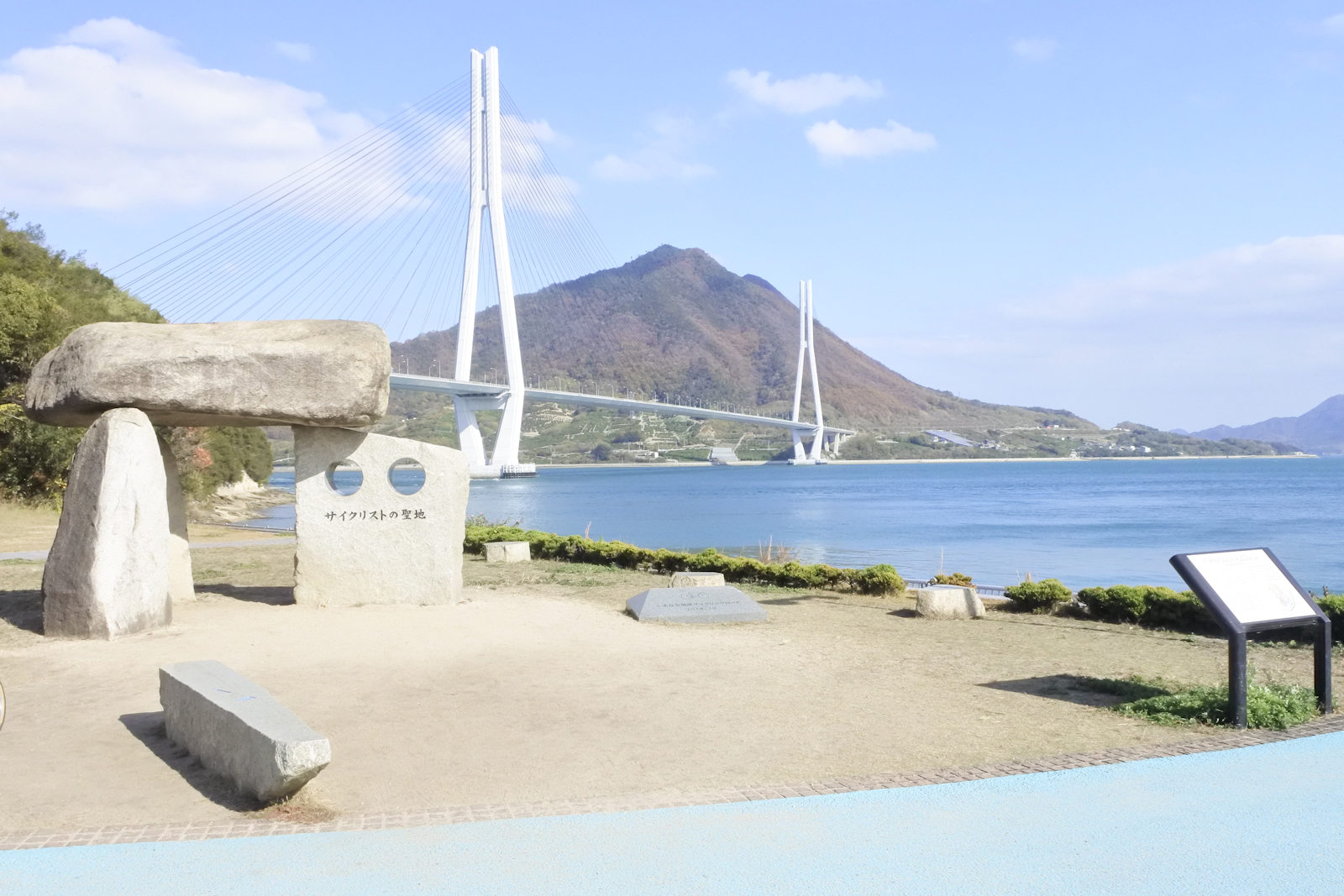
しまなみ海道と愛媛・香川を巡る旅 船・自転車・バスで渡るしまなみ海道
2日目の11月24日は、船・自転車・バス、3つの乗り物で瀬戸内しまなみ海道を渡る。瀬戸内しまなみ海道は広島県尾道市から愛媛県今治市までを、瀬戸内海に浮かぶ芸予諸島の7つの島(向島、因島、生口島、大三島、伯方島、大島、馬島)を経由する高速道路。高速道路に並行して、島と島をつなぐ橋、および各島の一般道から成る「しまなみ海道サイクリングロード」が整備され、多くのサイクリストたちが訪れている。「しまなみ海道サイクリングロード」は、日本のサイクリングロードとしては初めて、世界的に有名なガイドブックである「ロンリープラネット」「ミシュランガイド」の両方に紹介された。また、アメリカ合衆国のテレビ局、CNNでも「世界で最も素晴らしいサイクリングロードの1つ」であると紹介された。サイクリングロードは1999(平成11)年に開通、高速道路は2006(平成18)年全線開通した。瀬戸大橋、明石海峡大橋・大鳴門橋とともに、本州四国連絡橋の1つに数えられる。尾道駅前港からは、生口島行きの船「シトラス」に乗り、終点の生口島瀬戸田港を目指す。尾道駅前港~生口島瀬戸田港間の所要時間は約45分。港から東方向へ歩いて10分ほどのところにある耕三寺を参拝。耕三寺は昭和年間に建立された比較的新しい寺。初代住職、耕三寺耕三(こうさんじ・こうぞう、1891 - 1970)和上が母親の菩提寺として、母親の故郷である生口島に建立した。また、境内を日本各地の著名な歴史的建造物を模した寺を造り、生口島が誇る文化財にしたいという耕三和上の思いも込められている。境内の一番奥にある「未来心の丘」は、広島県出身の彫刻家、杭谷一東(くえたに・いっとう)さんが制作した白い大理石の彫刻・モニュメントが立ち並ぶ。大理石は杭谷さんがアトリエを構えるイタリア・カッラーラで採掘されたものを使っており、コンテナ船で生口島まで運ばれてきた。大理石に囲まれた風景は異国情緒にあふれ、テレビ番組などでもたびたび紹介されてきた。参拝後は、「しまなみ海道サイクリングロード」へ。耕三寺近くにある瀬戸田町観光案内所で自転車を借りる。生口島の海岸線沿いを通る生口島循環線を反時計回りに南下。この日は澄んだ青空が広がり、海が綺麗に見えた。道路沿いのところどころににみかんの木が植えられ、枝もたわわに実っていた。自転車を漕いで渡る最初の橋は生口島~大三島間をつなぐ多々良大橋。この橋の途中で広島県と愛媛県の県境がある。しまなみ海道沿線の大三島より南の島々は愛媛県今治市に属する。僕にとっては2007(平成19)年以来、16年ぶり2回目の愛媛県来訪である。多々良大橋を渡り、一般道へのアプローチを下りてすぐにある道の駅多々良しまなみ公園で、ランチタイムも兼ねて休憩を取ることに。先ほど渡った多々良大橋を多々良しまなみ公園の海辺から望む。僕はランチに鯛カツバーガーを食べた。愛媛県では古くからマダイが多く獲れ、養殖も盛ん。マダイをお米と一緒に炊き込んだ、あるいは醤油だれに漬け込んだマダイのお刺身を白ご飯の上に乗せた「鯛めし」も郷土料理として知られている。マダイの切り身に衣を付けて揚げた鯛カツもご当地グルメの1つ。鯛カツバーガーを食べ終え、再び自転車を漕ぐ。大三島でも海沿いの大三島環状線を南下。瀬戸港を過ぎた辺りから上り坂となり、その坂道を上がり、鼻栗瀬戸休憩所を過ぎて右に曲がると大三島橋へ。橋を渡り終えると、「伯方の塩」で有名な伯方島に上陸。アプローチを下りて国道317号(実は生口島循環線と大三島環状線も国道317号の一部)へ。道なりに進むと道の駅伯方S・Cパークに到着。自転車を漕ぐのはここまで。今治駅行きのバスが来るまでの間に、自転車の返却手続きをして、伯方の塩ソフトクリームを食べながら休憩した。道の駅近くの伯方島バスストップから乗るバスは、瀬戸内海交通バスの松山・今治〜大三島線の今治駅前行き。バスはしまなみ海道と島の一般道(国道317号)を行ったり来たりしながら今治方面へと進む。伯方・大島大橋を渡って大島に上陸して最初に停車する大島営業所バス停では運転手さんの「プロの業」を見ることができた。狭い車庫の中にあるバス停に、巧みなハンドルさばきでバスを操り、停車させた。バスは宮窪峠の坂道を走り、大島北部の宮窪地区から南部の吉海地区へ。亀山バス停を過ぎると、大島南インターチェンジからしまなみ海道へ。しまなみ海道最後の橋である来島海峡大橋を渡る。四国に上陸し、今治北インターチェンジでしまなみ海道を下りる。国道317号をしばらく南東方向に走ると、終点の今治駅前バス停に着いた。船・自転車・バスを乗り継いで渡るしまなみ海道の旅は無事にゴールできた。しまなみ海道でしかできない自転車で瀬戸内海を渡る体験をできたことが何よりも印象深かった。On the second day of the travel to Hiroshima, Ehime, and Kagawa, I travelled in the Geiyo Islands along with the Shimanami Kaidō by ship, bicycle, and bus.The Shimanami Kaidō Cycling Road, connecting City Onomichi, Hiroshima Prefecture and Imabari, Ehime Prefecture, goes through nine of the Geiyo Islands in Seto Inland Sea (Mukaishima, Innoshima, Ikuchijima, Ōmishima, Hakatajima, Michikajima, Ōshima, Mushijima, and Umashima) in parallel with the Setouchi Shimanami Kaidō Expressway.The Cycling Road opened in 1999, and the Expressway opened in 2006.The Cycling Road was on world-famous guide books, Lonely Planet and Michelin Guide. In addition, CNN News introduced it as one of the “Most Beautiful Cycling Roads”.From Onomichi Port, I boarded “Citrus” ship to Setoda Port in Ikuchijima. It took about 45 minutes via Innoshima.On Ikuchijima, I visited Kosan-ji Temple, taking a 10-minute walk from the port.The temple was constructed in the Shōwa Period by the first chief priest, Kōzō Kosanji, to show his thanks to his mother. In addition, he wished the temple to become cultural property in Ikuchijima.The “Miraishin-no-oka” garden paved with marble is farthest from the gate (fourth photograph).The marble sculptures and monuments in the garden were created by Itto Kuetani, a sculptor born in Hiroshima. The marbles were mined in Carrara, where his studio is located. The sculptures and monuments were shipped by sea.Some Japanese TV show has introduced the garden as an exotic place.After visiting the temple, I went to the tourist information centre near the temple to rent a bicycle.Once going back to the Setoda port, I cycled southward along the Seto Inland Sea. On my way, I sometimes saw prolific Satsuma mandarin trees. The first bridge during my cycling was the Tatara Ōhashi Bridge between Ikuchijima and Ōmishima. In the middle of the bridge, I passed the border of Hiroshima and Ehime (fifth photograph). The six islands from there (Ōmishima, Hakatajima, Michikajima, Ōshima, Mushijima, and Umashima) are part of Imabari City, Ehime.I dropped a rest stop near the exit of the approach from Tatara Ōhashi Bridge for lunch.Before eating lunch, I photographed the view of the Tatara Ōhashi Bridge (sixth photograph).I chose a hamburger with fried red sea bream.The red sea bream is one of the most popular fish in Ehime Prefecture. People in Ehime have caught and farmed the bream and sometimes eat cooked rice with the bream or raw sliced bream topped with the cooked rice.After finishing lunch, I restarted cycling toward the next island, Hakatajima. In Ōmishima, the cycling road spreads along the sea. A long upward slope started from the Seto Port to the entrance of the approach to the Ōmishima-hashi bridge. Crossing over the bridge, I came to Hakatajima.Going down the approach, I follow the cycling road to a rest stop. I returned the bicycle and ate salt-flavoured twisted ice cream because Hakatajima is famous for the salt industry.After my rest, I got on the bus to Imabari Station at the bus stop near the rest stop. The bus went and came to the Shimanami Kaidō Expressway and the general roads.I saw a skilful steerling at the first bus stop in Ōshima, which stands in the bus garage. A bus driver changed the bus direction, paying attention to not crashing the buses staying in the narrow garage.Going up the Miyakubo Path, the bus went into the south part of the island, the Yoshimi Area. Passing the Kameyama Bus Stop, the bus went up to the Shimanami Kaidō Expressway again to cross the Kurushima Kaikyō Ōhashi Bridge.After crossing the bridge, the bus went down to the general road in Imabari City. Going southeastward, the bus arrived at Imabari Station terminal.My first travel to the Shimanami Kaidō was very impressive, especially cycling.
Nov 24, 2023
コメント(0)
-
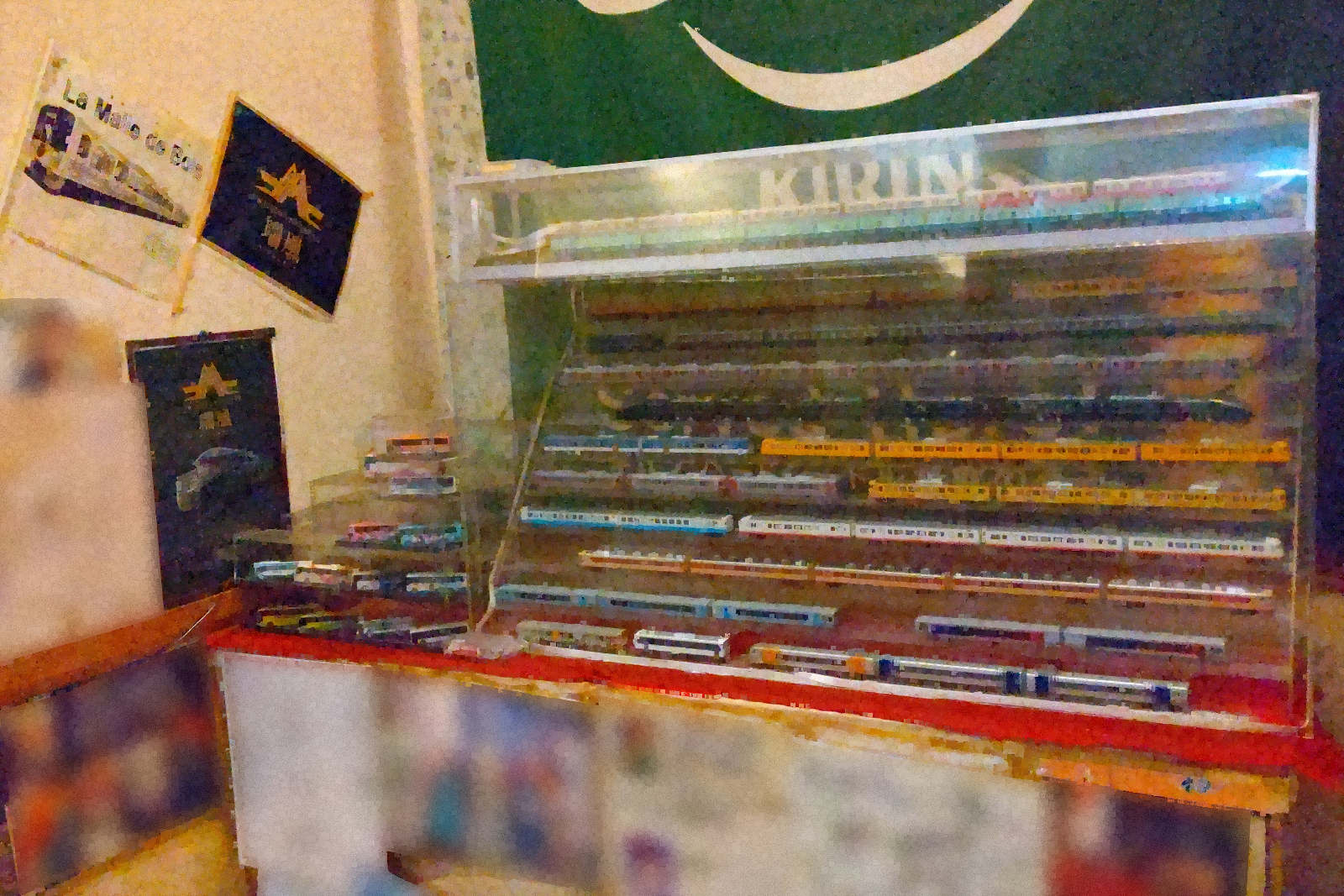
しまなみ海道と愛媛・香川を巡る旅 鉄道模型があるお好み焼き店
23日の夕食は尾道駅近くのお好み焼き店「すみチャン」へ。尾道駅南口から西(糸崎方)へ、福屋百貨店としまなみ交流館の間を抜けて、最初の信号のある交差点を左へ曲がるとすぐに見える。店内に入ってすぐには、テレビ番組で訪れた芸能人の方々のサイン色紙とともに、店長の趣味だという鉄道模型が飾られている。さて、僕が今回食べたのは、「尾道焼き」。広島お好み焼きの1種で、砂ずり(砂肝)といか天が入っていることが特徴。それに加えて、すみチャンの尾道焼きにはレンコンの薄切りも入っていた。広島お好み焼き特有の焼きそばの麺に加えて、砂ずりのコリコリとした食感とレンコンのシャキシャキとした食感が混ざり合い、以前に食べた広島お好み焼きとは少し違う味と食感だった。お好み焼きはお皿に乗せたまま食べるか、熱した鉄板に乗せてもらうかが選べる。広島お好み焼きらしさを出したいため、僕は鉄板に乗せてもらった。今回僕は予約をしなかったものの、人気店のため来店の際には事前予約推奨。At night time, I went to an okonomiyaki restaurant, "Sumi-chan", near Onomichi Station.From the south gate of Onomichi Station, you turn right. As you walk forward, you will see Fukuya Department Store on your right and Shimanami Kaikan Hall on your left. At the first crossing with signals, you turn left. In a few seconds, you reach the restaurant.I found model trains in a showcase soon after entering the restaurant. These model trains are the restaurant master's collection.I chose to eat Onomichi-yaki, one kind of okonomiyaki in Hiroshima style.Okonomiyaki in Hiroshima style is cooked using flour, shredded cabbage, Chinese noodles, and an egg. In addition, Onomichi-yaki uses chicken gizzard and sliced squid tempura. The one served here also includes sliced rotas loot. It tasted different from a Hiroshima-style okonomiyaki I ate before because of the chicken gizzard and rotas loot.When my Onomichi-yaki was served, the staff asked me if the Onomichi-yaki was on the dish or the hot plate. I chose the hot plate, the popular style in Hiroshima.Though I didn't book this time, I recommend you book the restaurant.
Nov 23, 2023
コメント(0)
-
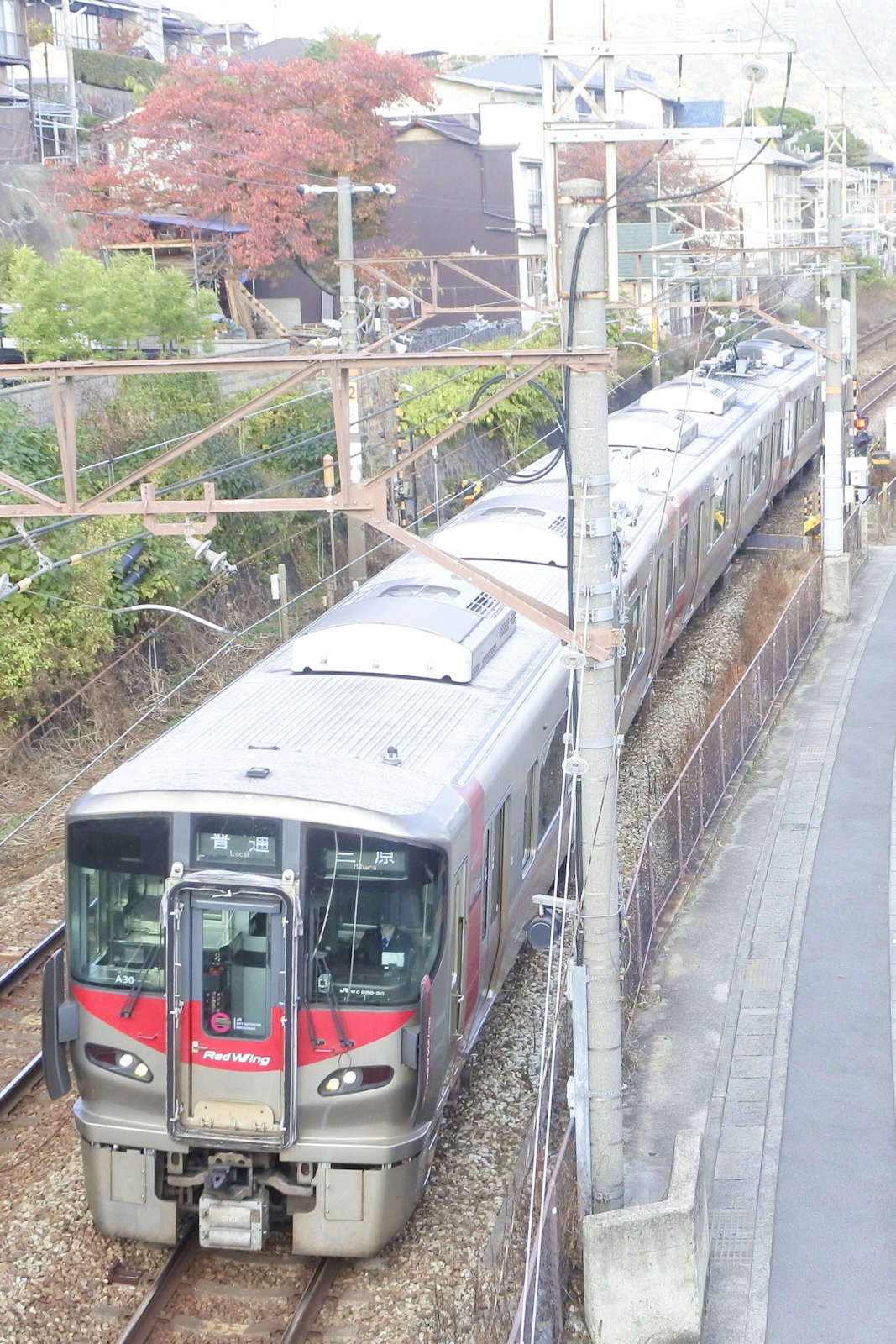
しまなみ海道と愛媛・香川を巡る旅 2種の227系を撮る
JR西日本山陽本線の広島県内の区間では227系電車が主力車両として運行されている。中でも福山駅~三原駅間は、下関総合車両所広島支所(広ヒロ)に所属する編成と、下関総合車両所岡山電車支所(岡オカ)に所属する編成の2種が乗り入れる。今回の旅ではどちらの編成も撮影できた。下関総合車両所広島支所に所属するヒロA30編成 A30 set belonging to Hiroshima Railyard1枚目は下関総合車両所広島支所所属車両。広島支所所属車両は、2015(平成27)年に登場した227系で最初に製造されたグループ。「Red Wing」の愛称で呼ばれ、広島県・山口県内の山陽本線、呉線、可部線で運行している。もみじ(イロハモミジ・カエデ)やプロ野球チームの広島東洋カープ、世界遺産・厳島神社の大鳥居を連想させる広島らしさを出した赤色が特徴。 下関総合車両所岡山電車支所に所属するオカR1編成 R1 set belonging to Okayama Railyard2枚目は下関総合車両所岡山電車支所所属車両。岡山電車支所所属車両は2023(令和5)年に登場した227系最新のグループ。「Urara」の愛称で呼ばれ、岡山県・広島県内の山陽本線、伯備線、宇野線、瀬戸大橋線で運行している。8月29日の日記でも紹介しているので、詳細は省略するが、岡山のモモ、福山のバラ、尾道のサクラの花を表すピンク色が特徴。2023(令和5)年11月時点で、「Urara」が尾道・三原方面に乗り入れる運用は普通417M列車(13:50岡山駅発~15:32三原駅着)と普通426M列車(15:44三原駅発~17:30岡山駅着)、普通1755M列車(17:55岡山駅発~19:18糸崎駅着)と普通1776M列車(19:39糸崎駅発~21:05岡山駅着)の2往復のみ。貴重な「Urara」の撮影チャンスに巡り合うことができた。While in Onomichi, I photographed two types of 227 Series on Sanyo Main Line.The first is A30 set belonging to Hiroshima Railyard. 227 Series from Hiroshima serves on Sanyo Main Line, Kure Line, and Kabe Line. These carriages are nicknamed "Red Wing" after their line colour, coming from maple leaves (the symbol tree of Hiroshima Prefecture), Hiroshima Carp (a Japanese baseball team based at Hiroshima), and floating torii gate of Itsukushima Shrine.The second is R1 set belonging to Okayama Railyard. 227 Series from Okayama serves on Sanyo Main Line, Hakubi Line, Uno Line, and Seto-ohashi Line. These carriages are nicknamed "Urara" after the weather on a pleasant spring day with soft sunshine. These have colourful lines. Among them, the pink shows the three flowers (peach blossom, rose, and cherry blossom).I already wrote about "Urara" in detail on my blog on August 29th.The chance for "Urara" to come to Onomichi is only four times daily (in November, 2023). I got a rare chance to shoot the carriages.
Nov 23, 2023
コメント(2)
-
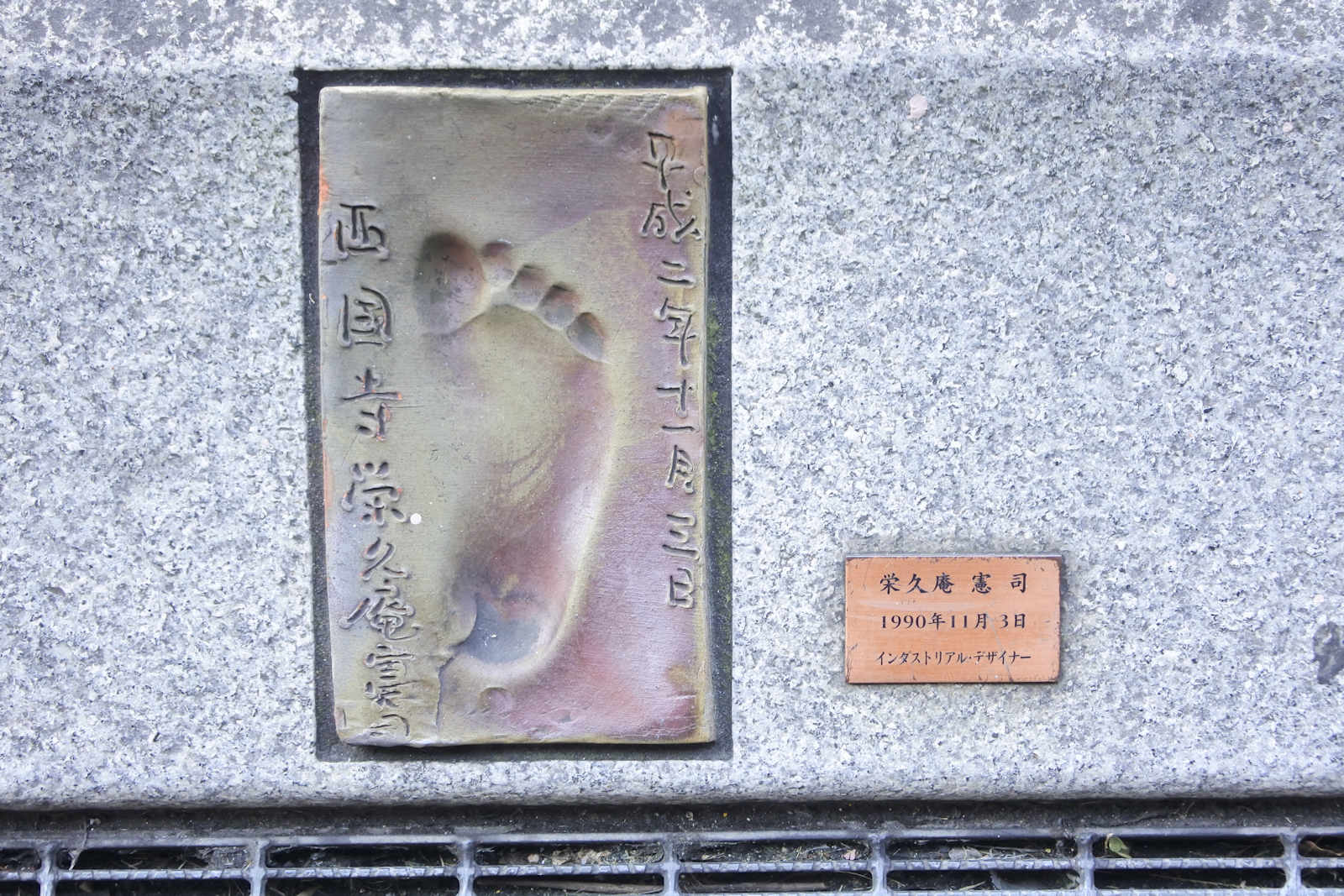
しまなみ海道と愛媛・香川を巡る旅 尾道・千光寺公園
11月23日から26日まで、僕はしまなみ海道と愛媛・香川を旅してきた。JR東海東海道新幹線・JR西日本山陽新幹線「のぞみ」とJR西日本山陽本線の普通列車を乗り継いで尾道駅へ。駅近くでランチを食べ、線路沿いの駅前商店街を東尾道方へ歩き、千光寺山ロープウェイ山麓駅を目指す。その道すがら、僕は歩道の路面の車道との境界近くに著名人の足型が飾られているのを発見した。その中には、JR東日本E3系新幹線電車やJR西日本227系電車など鉄道車両のデザインにも多く携わった榮久庵憲司さん(1929 - 2015)のものもあった。15分ほど歩いて千光寺山ロープウェイの山麓駅に到着。ここからロープウェイに乗車。尾道の街並みや穏やかな瀬戸内海を後ろに見ながら、ロープウェイは進む。進行方向左側に千光寺の本堂、右側に鐘楼が見えると、山頂駅はもうすぐ。山頂駅からは著名な作家・詩人の文学碑が点在する文学のこみちを下り、千光寺へ参拝。本堂から階段を上がったくさり山の近くから尾道の街を見下ろす。山陽本線の線路も見える。ここから尾道の風景と山陽本線の列車を入れた1枚を撮影する。EF210形電気機関車牽引の貨物列車、千光寺本堂、瀬戸内海(尾道水道)、瀬戸内しまなみ海道の新尾道大橋を入れた、尾道の魅力をぎゅっと詰め込んだ1枚に仕上がった。From November 23rd to 26th, I travelled to Hiroshima, Ehime, and Kagawa Prefectures.First, I came to Onomichi Station via Shinkansen and Sanyo Main Line. After eating lunch, I walked along the railway toward Higashi-onomichi to go to the station on Senkoji Ropeway cablecar. While walking in the shopping area, I found the footprints of celebrities, such as Kenji Ekuan (1929 - 2015), an industrial designer famous for some railway carriages in Japan.While travelling, I saw the scenery of Onomichi and Seto Inland Sea from the back of the gondola. From the station on the top, I walked down to the Senko-ji Temple.I photographed a freight train against the main hall of Senko-ji, Seto Inland Sea, and Shin-onomichi Bridge on the Setouchi Shimanami Kaido Expressway.
Nov 23, 2023
コメント(2)
全9件 (9件中 1-9件目)
1
-
-

- フォトライフ
- 源氏物語〔10帖 賢木 15〕
- (2024-11-14 10:20:09)
-
-
-

- 動物園&水族館大好き!
- 🐠【沖縄美ら海水族館、新種深海魚「…
- (2024-11-13 19:39:46)
-
-
-

- 美術館・展覧会・ギャラリー
- 雲間 Drawingにコラージュ
- (2024-11-14 06:49:29)
-






